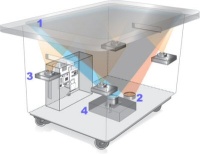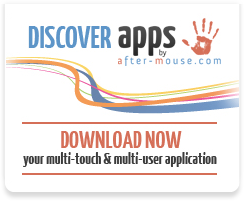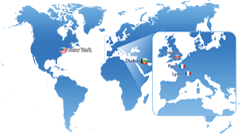Microsoft PixelSense™
Introduction

Announced in 2007 and launched in 2008, Microsoft® Surface® marked the beginning of a completely new, intuitive relationship between people and technology. Almost three years later, Microsoft® has revolutionized the world of touch-screen computing once more with amazing technical and physical specifications.
True to its "multi-touch" and "multi-user" principle, this all-new unit allows digital content to be directly manipulated by touch, and the 360° interface enables several users to interact with each other simultaneously (more than 50 touches simultaneously). Object recognition also remains a core feature of Microsoft® PixelSense™.
The major change in this latest version is the adoption of Windows 7/8, making for easy portability to all types of hardware running the same operating system. AFTER-MOUSE.COM is one of the first companies to offer multi-platform application development: a single application can be deployed on Microsoft® PixelSense™, touch screens, laptops, tablet PCs, walls, Windows® Phone 7 cell phones and even on the web, thanks to Silverlight's touch capabilities!
In addition, Microsoft® Surface® now supports dual orientation: horizontal as before, and now also vertical, thanks to a thickness of only 4 inches and integrated corner-mounted accelerometers. High-end professional applications are made possible by the new technical specifications: powerful processor and graphic cards, 40" full-HD screen, memory of up to 8 GB, etc. The physical properties of the unit have also been improved, with a reduced weight and removable feet making it easily transportable.
Discover our custom-made developments.
The new specifications make it unique:
- A touch screen experience based on vision with PixelSense™, Microsoft® Surface® sees and responds to touch and objects
- Dual orientation: vertical and horizontal, integrated corner-mounted accelerometers, and only 4" thick
- Direct interaction: users interact with content through touch and gesture, with no intervening physical device such as a mouse. With the passing of the mouse, the way is open for the era of touch, the "AFTER-MOUSE.COM" era
- Multi-touch: the unit can recognize over 50 touches simultaneously, so even more than one person can work with both hands together
- Multi-user: the horizontal 40" screen makes it easy for several people to work together around the device
- Object recognition: physical objects are recognized via special tags or simple shape recognition by being placed on the display.
Technical data
A PC running Microsoft Windows 7/8 is integrated into the device.
| Physical specifications |
|
| Display |
|
| Computer |
|
| Network |
|
| Peripherals |
|















